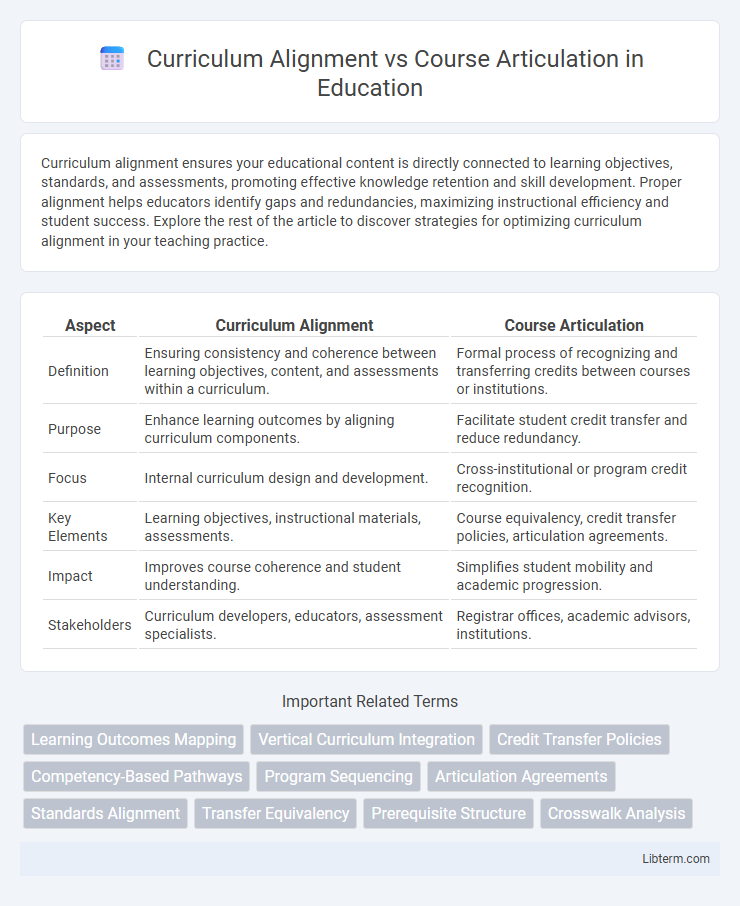Curriculum alignment ensures your educational content is directly connected to learning objectives, standards, and assessments, promoting effective knowledge retention and skill development. Proper alignment helps educators identify gaps and redundancies, maximizing instructional efficiency and student success. Explore the rest of the article to discover strategies for optimizing curriculum alignment in your teaching practice.
Table of Comparison
| Aspect | Curriculum Alignment | Course Articulation |
|---|---|---|
| Definition | Ensuring consistency and coherence between learning objectives, content, and assessments within a curriculum. | Formal process of recognizing and transferring credits between courses or institutions. |
| Purpose | Enhance learning outcomes by aligning curriculum components. | Facilitate student credit transfer and reduce redundancy. |
| Focus | Internal curriculum design and development. | Cross-institutional or program credit recognition. |
| Key Elements | Learning objectives, instructional materials, assessments. | Course equivalency, credit transfer policies, articulation agreements. |
| Impact | Improves course coherence and student understanding. | Simplifies student mobility and academic progression. |
| Stakeholders | Curriculum developers, educators, assessment specialists. | Registrar offices, academic advisors, institutions. |
Understanding Curriculum Alignment
Curriculum alignment ensures that learning objectives, instructional methods, and assessments are consistently connected across grade levels or courses to promote cohesive student learning outcomes. It focuses on mapping curriculum standards to classroom activities and evaluations, enhancing educational coherence and effectiveness. Understanding curriculum alignment helps educators identify gaps or redundancies within the curriculum, supporting targeted improvements.
Defining Course Articulation
Course articulation defines the formal process of establishing equivalencies between courses across different educational institutions to ensure seamless credit transfer for students. It involves detailed comparison of course content, learning outcomes, and assessment methods to determine compatibility. Effective course articulation supports academic mobility and reduces redundancy in learning pathways.
Key Differences Between Curriculum Alignment and Course Articulation
Curriculum alignment ensures instructional content and assessment methods across grade levels or courses match established learning standards, promoting coherent educational progression. Course articulation focuses on formal agreements between institutions that recognize course equivalencies for credit transfer. The key difference lies in curriculum alignment managing internal consistency within an institution, while course articulation facilitates external credit recognition across different educational entities.
Importance of Curriculum Alignment in Education
Curriculum alignment ensures that learning objectives, instructional materials, and assessments are cohesively integrated to enhance student achievement and maintain educational consistency across grade levels. This alignment plays a critical role in meeting academic standards, facilitating smooth transitions between courses, and supporting personalized learning pathways. Emphasizing curriculum alignment promotes equity in education by providing all students with clear, measurable goals and a structured framework that guides effective teaching and assessment practices.
The Role of Course Articulation in Student Success
Course articulation plays a crucial role in student success by ensuring transferable credits between institutions, which eliminates redundant coursework and accelerates degree completion. This process facilitates clear pathways for students transitioning from community colleges to universities, maintaining academic rigor and consistency across programs. Effective course articulation agreements reduce time and financial barriers, enabling students to progress efficiently toward their educational and career goals.
Benefits of Effective Curriculum Alignment
Effective curriculum alignment enhances student learning outcomes by ensuring consistency between course objectives, instructional activities, and assessment methods. It promotes seamless progression through educational programs, reducing content overlap and knowledge gaps. This alignment supports accreditation requirements and improves institutional accountability by clearly demonstrating that curricula meet established academic standards.
Challenges in Achieving Course Articulation
Achieving course articulation faces challenges such as inconsistent curriculum standards, varying accreditation requirements across institutions, and misalignment of learning outcomes that hinder smooth credit transfer. Differences in course content depth, assessment methods, and credit hour definitions complicate the recognition of equivalent courses. Administrative barriers and lack of clear communication channels between institutions further impede efficient course articulation processes.
Strategies for Aligning Curriculum Across Institutions
Effective strategies for aligning curriculum across institutions involve establishing shared learning outcomes and competency frameworks that ensure consistency in student knowledge and skills. Collaborative committees and cross-institutional workshops facilitate the development of standardized syllabi and assessment criteria, promoting seamless credit transfer and reducing redundancy. Utilizing data-driven mapping tools enhances curriculum coherence, supporting both curriculum alignment and course articulation processes for better academic integration.
Best Practices for Successful Course Articulation
Effective course articulation requires clear curriculum alignment to ensure learning outcomes match across institutions, facilitating seamless student credit transfer and progression. Best practices include establishing standardized course descriptions, utilizing common rubrics for assessment, and maintaining ongoing faculty collaboration to update and synchronize curricula. Implementing robust data tracking systems supports transparency and continuous improvement in articulation agreements.
Integrating Curriculum Alignment and Course Articulation for Seamless Learning
Integrating curriculum alignment and course articulation ensures seamless learning by synchronizing learning objectives, content standards, and assessment criteria across educational levels and institutions. This integration facilitates clear pathways for student progression and credit transfer, reducing redundancy and gaps in learning. Aligning curricula with articulated courses supports consistent skill development and prepares students effectively for subsequent academic or career challenges.
Curriculum Alignment Infographic

 libterm.com
libterm.com